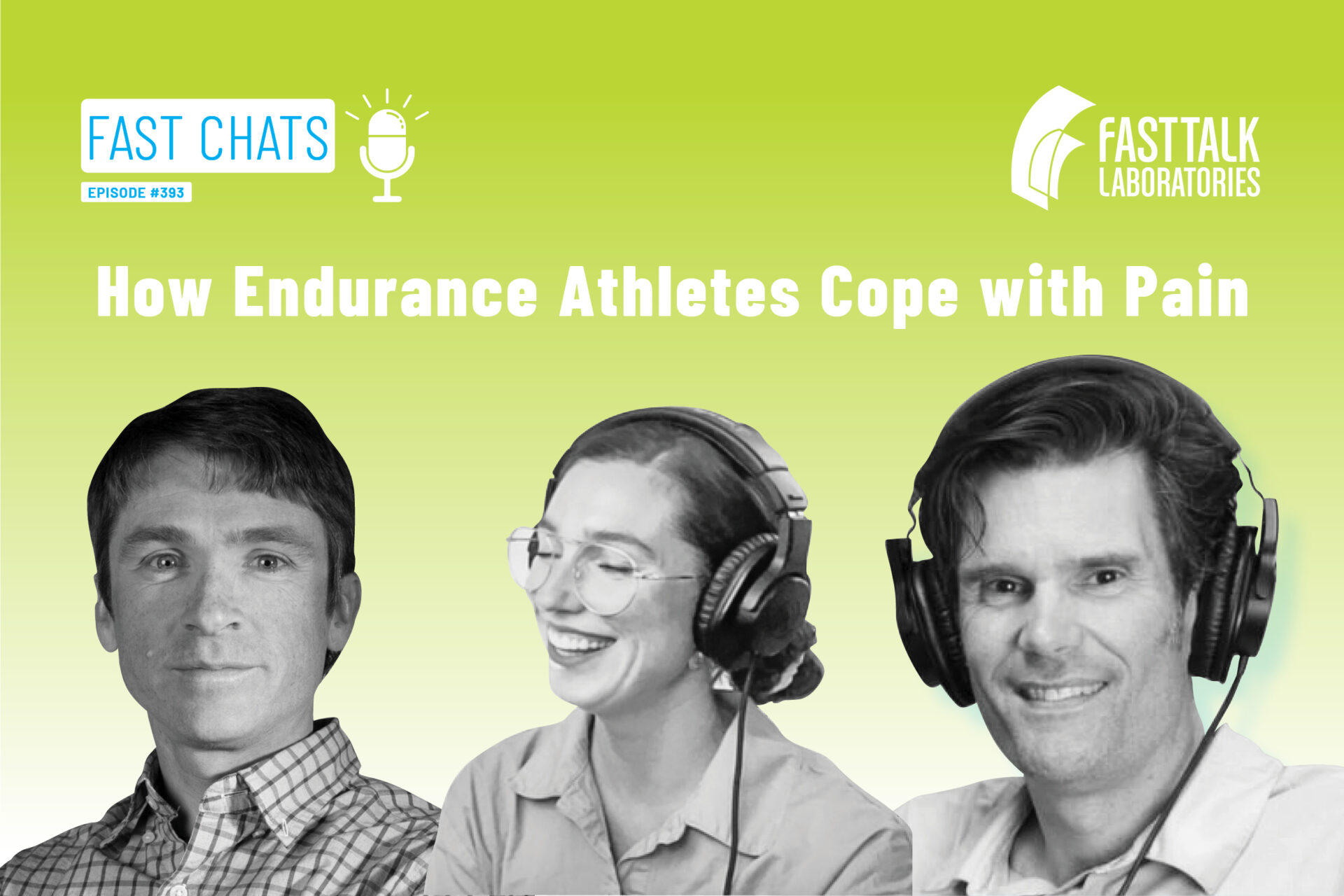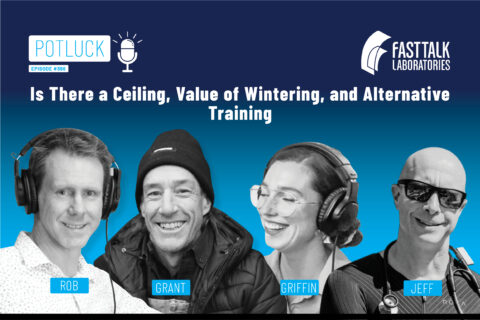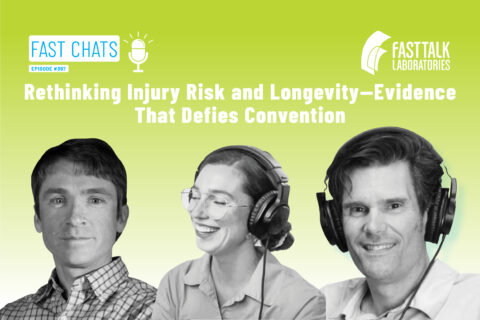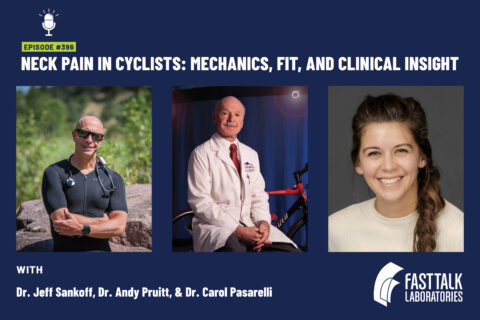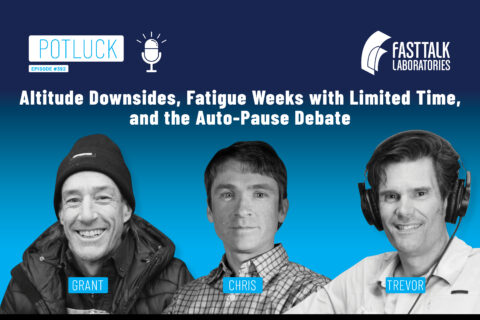We unpack what pain really means in endurance sport and how ultra-athletes use interoception, mindset, and adaptive coping (vs. maladaptive spirals) to finish stronger—less suffering, more control.
Episode Transcript
Chris Case 00:01
Hey everyone, welcome to another episode of fast talk. I’m your host, Chris case, here with Trevor Connor and Dr Griffin McMath. This is a fast chats episode. Today’s theme is pain, and I’m going to put that in air quotes, because we’re going to talk about various definitions of pain. We’re going to talk about how people reframe pain and so forth. The studies we’ve chosen actually, the subjects mostly come from the ultra running, ultra marathon world, and that’s probably because that’s a really hard sport, and there’s a lot of various forms of pain and hunger and fatigue. And we’re going to get into that. Trevor, the first article we’re going to talk about is a review from 2025 Do you want to give us the brief synopsis of what is going on in this paper?
Trevor Connor 00:50
Yeah, I’ll start. And I think Griffin can really help me here, because there is a lot in this one. So to start with, let’s give the name of this review. It’s called human resilience and pain coping strategies, a review of the literature giving insights from elite ultra endurance athletes for sports science, medicine and society. And the lead author is potentially a DR Carol Paley.
Chris Case 01:11
This is out of Leeds, yep, West Yorkshire,
Trevor Connor 01:14
so it’s hard to give a summary, but as you said, like all three studies, they focused on ultra endurance runners, because pain, frankly, is such a key part of their sport, and they are looking at how they handle pain and how it might be different from what you would see in the general population. And I would say, if I was trying to summarize it, I actually pulled out of their conclusions, their summary, they basically said that these athletes have a better pain tolerance. They have a better mental toughness. And that’s important, because those seem to go hand in hand, right?
Chris Case 01:49
Pain tolerance is both potentially a physiological and psychological right?
Trevor Connor 01:53
So they do talk about the physiological sides of the note you I could never pronounce that. No set, no choice,
Chris Case 01:59
nociception.
Trevor Connor 02:00
We’re gonna have fun with me not be able to say that word once.
Griffin McMath 02:03
I actually don’t want to correct because I just want to keep witnessing you.
Trevor Connor 02:07
I will entertain you and keep trying to say it that you can see this afferent effect where you can basically dampen the sum signals, and actually the signals that blunt pain reception, those seem to be elevated. So there’s definitely a physiological side to it, but they also do show that there’s a mental side to it. So I think that’s really important. And on that mental side, another word that hopefully I can pronounce, this one, is interoception. They talk a lot about this. This is your ability to read your own body, your sense of self. They quote this author, Dr Craig, who came up with this theory that pain is actually what he calls a homeostatic emotion. It is a emotion that basically is trying to tell you you’re at a homeostatic balance. Get back into homeostasis. It’s a physical cue, right? And they talk about these elite athletes are able to modulate and control that interoception better than non athletes. So that’s a summary. Griffin. What do you have to add to that? I think what made this such a worthwhile read, to me was it was a little bit unintentionally poetic. They kind of collapsed the dimensions of pain and looked at it from the coping mechanism capacity. So if you look at the coping mechanism to deal with pain, it’s about anchoring focus. And one of the things we know that pain ends up being a massive distraction when you’re at that point on the trail or on the race, they did the same thing across numerous dimensions of pain. And I know, again, we have the air quotes around what pain is. But for the sake of this conversation, they basically took an umbrella term and said, Let’s identify common experiences that people may associate with pain. So you know, you did talk about the interoceptive training, which is that awareness of internal signals. They talked about mindfulness, which is just being aware of the present moment to produce catastrophizing, which can be that spiral. And we’ll get into that with the second paper later. Visualization, imagery is to help anchor that focus. We talked a little bit about the emotional aspects of emotional regulation to prevent that distress that’s associated with the spiral once you’re already down it and then really, one of my favorite topics for any type of resilience, for any athlete, is internal locus of control, so sustaining agency and persistence, so you are driving the ship, not pain, really remembering who’s boss. What’s different about this review that I really appreciated from a clinical standpoint, especially as they broke down these different dimensions, was what population they actually connected athletes to which you wouldn’t necessarily think to connect with Trevor. Do you want to talk about how they dove into that? There’s a lot of. Directions that we can go in with this, because they go back to that population multiple times. And I found it very interesting when they talked about fibromyalgia and brought up the fact that we were talking about this. Here we go again. Nociceptive, no scepter control that they see in people with fibromyalgia, kind of the opposite effect of what you see in athletes, that you get too much of a signal, and there’s an inability to control that signal, which really feel bad for those people, that they have to go through that sort of pain. But they do bring up here, and this is kind of a theme through all the studies we’re going to mention, adaptive versus maladaptive techniques, they even say, we actually don’t know if these make a difference or not, but they seem to. But there are adaptive coping strategies and there are maladaptive coping strategies. And basically say, you see in these elite athletes, a lot of the adaptive covid strategies being used, where often people who are in chronic pain, you see the more maladaptive. So one of the maladaptive things that people do is catastrophizing. You start to feel pain and look you and I both have migraines. It’s a hard thing not to do because, for example, with migraines, you get that halo effect before you get the pain, and when you get that, there’s that, oh, I’m gonna be writhing in pain in a few hours. And it’s hard not to catastrophize that a little bit and go, this is really gonna suck. And you start dreading it, and you start, you just start doing things, kind of obsessing it. Where these athletes, when they’re in the middle of an event and they’re feeling the pain. Adaptive techniques are things like kind of separating yourself from it and just saying, it is a signal. It’s a cue. They don’t over inflate it. As a matter of fact, they talk in this review about how the issue with this is a lot of these elite athletes are so good at doing this that they don’t hear the warning signals and they can injure themselves.
Chris Case 07:00
Yeah, I want to speak from the participant side too, and just make the grand distinction between someone with chronic pain, or, in your example, the halo comes. You know the migraine is about to come. You know that the pain is coming. It’s hard to see a positive side to that. Whereas, if you’re in an ultra race, there’s a giant reward. There’s a price to pay that you can call pain in air quotes. The reward is completion, competition, views, scenery, whatever. So you’re kind of like, ah, if it takes a little pain to get this grand reward, I’m going to deal with
Trevor Connor 07:40
- They actually take that further in the review, and they have a section that they title spirituality, resilience and social bonding. And said that for some athletes, this is almost a spiritual or religious experience, where they want the pain a right of past
Griffin McMath 07:55
exactly. I mean, Tough Mudder is completely based on that. A lot of things like that. Yeah, I think that what you call out there too, of having a reward or having this kind of spiritual bonding experience, what you said about chronic pain, what’s so important in case someone’s hearing this and thinking, Oh, I suffer from data, and therefore this pain I experience is my choice. We’re not saying what’s the chicken and what’s the egg here? And the difference of being chronic pain can either hit you when you’re not expecting it, or it can linger all the time, whereas in an ultra marathon, it’s going to hit for a finite period of time, and then once you hit that reward, and it’s a choice, so I think that’s just important, in case anyone’s hearing us thinks that they’re to blame.
Trevor Connor 08:38
Well, you brought up another really important point, which is, there’s a reward at the end. It could be a podium, it could just be a sense of accomplishment, right? But there’s something you’re working for. And look, I think a big part of this review was saying, let’s look at elite athletes how they manage pain, because they seem to be really good at it, and then try to teach some of those skills to people who have chronic pain, but might not necessarily be those elite athletes, and this is where I don’t want to sound negative, but I am going to point out the importance of those contacts, because I learned all those skills as an athlete, and I was really good at going into a race and going, oh my god, this hurts like you wouldn’t believe and be able to get through it, because I’d use those adaptive techniques. I find that harder with the migraine, because there is no reward. Yeah, exactly. It’s just you’re going to be going through some pain for a day or two and find out how to deal with it. And I do use some, you know, some of these tactics can be helpful. So I do want to have a positive side to that, you know, the separation. I really try to do that and just observe the pain. One thing that came across in all these studies is a technique that is not adaptive, because you just can’t do it, is to just say, I’m going to ignore the pain. And they pointed out that athletes don’t do that. They don’t turn off and not feel the pain. They just reframe it. Yeah, and so what I have a migraine, I try as best. As possible to just say I’m observing the pain and try to be unemotional about it.
Griffin McMath 10:05
So many episodes we read papers or reviews where we’re quantifying some type of thing, the difference in both papers today is that the data that we’re observing is what’s being qualified. And so this qualification of pain being a beautiful suffering, I think was in quotes, right? Or pain as these types of qualities. Rather than talking about intensity in some type of way, we’re really talking about the quality of the stimulus and what the athlete does to deal with said stimulus,
Chris Case 10:36
right? As I was reading especially the review paper, my mind kept saying, No, that’s not it can’t say that. I would love to survey a bunch of ultra runners and ask them what their definition of pain is and see if it fits with their definition of what they experience when they’re on the trail, because I personally don’t define them in the same way, if I cut myself, that’s pain. If I go out into a bike packing race or a 50k running race and I’m deprived of various comforts, I’m hungry, I’m tired, in some way, if I sprain my ankle during the race, I consider that pain these other things I don’t ever use that word for, and I would imagine that elite endurance and ultra endurance athletes especially don’t use that word very often, unless it’s with an acute injury or something that is more akin to cutting themselves or breaking a bone or something like that, but there’s other more specific words for them, and what I’m getting at here is that, in and of itself, is a reframing and a way to distance yourself from pain and be consumed by that word and that concept and move through it in A different way.
Trevor Connor 12:01
So I do think that is partially addressed in all of these papers, because they do point out the fact that in ultra endurance runners, most of them, over the course of event, you are going to see some what they call e, i, m, d, exercise induced muscle damage, which is more akin to what you’re talking about. It is little damage to your muscles, but they do point out the fact that a lot of these athletes will get injured and will continue to run through it, right? So might have that angle injury, or Achilles tendon damage,
Chris Case 12:33
or a giant saddle sore from a seven day or 12 day bike packing race, you know, like, are we speaking from personal experience? No, actually, not. I’ve had other things happen in bike packing races, but no, I have never had really debilitating things that I’ve seen people ride through and gruesome. I would continue to do
Griffin McMath 12:52
that if we asked your survey question as a forum question, how do you define pain during race or training? I think something you hear too in biofeedback, if I had a patient in and we were doing biofeedback, there are so many different tools to do this, but one of my favorite ones that’s really easy for most people to understand, is if you’re sitting in a chair in front of a mirror, you are basically observing something on your body where there might be tension, you can see something and you’re just processing that as information, basically biofeedback, meaning an observation or something that’s happening within you, and sending a signal that you interpret meaning from, and that interpretation itself is what can be manipulated for better positive outcomes. And I think that’s what’s so important here. With this particular review. I told before the episode, I was like, I’ve got a really great analogy. And I look at it as understanding that pain, or however you want to define it, is inevitable. It’s this passenger on your journey at a certain point. And if you think of that like a motorcycle with a sidecar. The sidecar is your pain. Either you spend the entire part of the race looking over and paying attention about your noisy companion, or you focus on the road ahead, knowing that they’re going to be with you regardless. And so I think that it’s more about focusing on making sure that your relationship to that pain, that connection, is healthy and strong and maladaptive.
Chris Case 14:27
I’m only laughing because, as you were describing that, I was like this sort of sounds like parenthood at times too, like you’ve got this noisy companion, ie a child next to you. You can focus on them, or you can focus on the road ahead and get the job done of parenting
Griffin McMath 14:42
that sidecar is going to be hooked on. Yes,
Suzy Sanchez 14:47
hey, coaches. This is Susie Sanchez from USA Cycling. We’ve partnered with fast talk laboratories to upgrade our coach education program. By the end of this year, USA Cycling will have over 50 new CEU courses for coaches produced by. Experts from fast stop labs, visit USA cycling.org backslash coaches to learn more.
Trevor Connor 15:07
Something you brought up earlier that I think, is a really important point here is what’s called the locus of control, that some people have a very internal locus of control, meaning they really do feel they are the masters of their own destiny and can control things, versus people who have an external locus of control, which is they believe the world kind of controls them. And that goes again, back to the athlete versus the person in chronic pain. When you’re an athlete, you choose to be in the race, you choose to go through that pain. You choose how you respond to it, whether you keep racing or don’t. So by nature, there’s a lot of internal locus of control here.
Chris Case 15:45
And to add to that point, I can also describe that in a couple other ways, elite athletes take those sensations within them and use it, whereas, if the sensation is thought to be external, it’s more an abusive relationship with that sensation outside of you, and therefore the person feels more like a victim, rather than someone in control of their own destiny.
Trevor Connor 16:10
It’s so here’s the issue. If you are somebody suffering from chronic pain, let’s say you have fibromyalgia, yeah, even if you’re somebody who naturally has an internal locus of control, it’s hard to have a condition like that and not go, this is completely outside of my control, absolutely. And so the question is, can you find ways to feel like you get some control over it?
Griffin McMath 16:30
And I think what’s so neat that this paper also talked about was adaptation to the pain, your relationship with pain as plasticity within your brain, and how your cells will actually remodel experiencing some of the stress if you do have an appropriate response and appropriate adaptation. So if you look at pain, especially those who don’t want great brain health along the way, if you reframe this as your brain exercise for the day or for the workout. Consider that every time you make a small choice that’s a little bit different, that’s more in your benefit in relationship to pain, this meaning making strategy can not only be so fantastic for your brain, but it starts to become a familiar path. And if you start to make a different path more familiar in your brain, then it becomes more possible, it’ll be the automatic choice for your brain.
Chris Case 17:25
That’s one of those things that I’m not sure they fully captured. There were some hints of it. But is the simple act of participating in ultra endurance events going to eventually lead people to come up with these strategies, or do people who are naturally attracted to these types of events, kind of have these mechanisms built in already, and therefore can do better at them and can have more success and joy participating in them.
Trevor Connor 17:52
That was the big question in the review that I was really glad they brought up, which is they basically said, there is some evidence that you can learn these skills, but we’re not going to say definitively, yes, they are learned skills. And they raise that question of clearly, these elite athletes have great pain coping skills, but did they learn those skills because they became elite athletes, or did they become elite athletes in a sport that has a lot of pain? Yeah, because they’re naturally very able to handle that pain. Well,
Griffin McMath 18:23
we’ve seen the endurance athlete community expand so much in the last five years, especially post pandemic and people having an interest in taking care of their health or these activities, but the ultra finishing percentage was still below. What is it? 60% 60 to something percent. So I think your likelihood, your propensity to sign up or to attempt Ultra is a completely different variable. But I think that whether or not you finish right DNF
Trevor Connor 18:52
talking about that, is it learned, or is it just people who this comes naturally to gravitate to the sport? There was one thing where they said there was a lot of evidence, so they talked about mental toughness. And mental toughness, they said, is highly associated with pain coping, and I love their definition of mental toughness, so I’m just going to read it. They said mental toughness is described as psychological resilience, or the ability to cope with various stressors, including pain and adversity. It is also associated with self efficacy, so that feeling that you have control persistence and being able to manage failure. I love that definition of mental toughness, and they do go on to say, lot of research has been done on mental toughness, and there seems to be evidence that mental toughness can be taught. So going back to I know we’ve been painting a bit of a bleak picture to people who suffer from chronic pain. And Griffin and I are two of them, some of these skills of mental toughness. You know, learning some of those skills may very well help for those people suffering from
Griffin McMath 19:53
chronic pain. I love that. And if I could snap my fingers and not have the migraine that we have, that’d be amazing. I will kind of go back to the point you made earlier about it kind of being this binary thing. Are people drawn to the sport because they have this innate skill, or is this sport what brings out the skill in people? And I think we have to think about the propensity toward Ultra or just endurance sports in general, has a few other independent variables, obviously, like what’s happened in the last several years and post pandemic, and people’s curiosity about longevity. And this is such a great segue to the second paper, Ultra, you may sign up, and we’ve seen record sign ups, especially for women, I think, in the last year or two. But DNF, I believe, has not changed. So don’t quote me on that completely or somewhere around 60% or so. And so that’s where this paper really comes in, in talking about pain and what is used to whether or not you finish, not necessarily your speed. So I think we should hop over to Trevor for the summary. I think you’re locked and loaded
Trevor Connor 21:00
here by doing the summary again. Oh, man, this one to you, but I’ll give the title. So this one is, it’s a little older. It’s a 2020, paper, and it is, pain is inevitable, but suffering is optional. Relationship of pain coping strategies to performance and multi stage ultra marathon runners. So Chris, you know this better than me. What was the race they were using?
Chris Case 21:21
So it’s the racing the planet 250 ultra marathon stage race, which is a six stage run, ultra marathon stage race through the desert, through the Sahara Desert, if I’m not mistaken. So the first four
Trevor Connor 21:35
days, you basically run a marathon each day, the fifth day, you run a double marathon, or almost one marathon, and then, for some strange reason, on the sixth day, you run five miles, yeah, but you have to carry your own food. Yes,
Chris Case 21:49
it’s a really big one. Yeah.
Griffin McMath 21:51
I’m going to open this with another analogy, which Chris your sign off your drum roll. This paper to me, reminded me more of what happens when you’re in quicksand, if you let your sympathetic take over, your sympathetic drive, and you fight the pain or you are so focused on that fear of what’s happening there, the deeper you will fall in, the more you will spiral this catastrophizing, the things we talked about from the maladaptive behaviors In the first review, start to take hold. But where this paper, I really, really appreciated, talked about the importance of having a stronger parasympathetic tone, and the things that you can do in order to have a different baseline. And it’s kind of like what happens with quicksand, relax a little bit, switch over, do not take the automatic, easy way out of sympathetic drive, tap into parasympathetic, and it’s going to be easier to finish. And that was one of the other keys of this paper, was that it didn’t look at whether or not this impacted speed so much as it realized that not giving in to the maladaptive behaviors meant you are more likely to finish. It wasn’t this toxic positivity paper of you have to do all these really great things and you’re going to finish and you’re gonna do great it was more just don’t do this and you’ll finish.
Trevor Connor 23:17
So to that point, what I found very interesting is they looked at six factors and tried to correlate them to both finishing and performance. Measured six things, pain intensity, race completion and finished position, exertion, coping and within coping. They looked at experiential awareness, adaptive pain coping and maladaptive pain coping and to your point, what I found really interesting was the only two things that correlated with whether the athlete finished or not was if they use maladaptive coping strategies. So those who use maladaptive tended to be more likely to not finish the race and age. That was that nice little here I’m reading a paper about pain and quick slap in the face. Oh, by the way, you’re old. You’ll finish as well. But
Griffin McMath 24:10
with the older population, they talk about a greater likelihood of gaining mental resilience, which could be tapped into, rather than chronological age. So you may be older, but you’re carrying some great experience.
Trevor Connor 24:24
But what was really interesting was adaptive strategies did not correlate, and none of them correlated with performance, but they did point out this is an event that people do more to just finish versus to get a result, so it might not be the best event to try to correlate with performance.
Griffin McMath 24:41
I think the one thing about using the population that was used in this study, though, is that it’s so extreme and so many extreme conditions. If you’ve ever watched the YouTube video of these athletes going through the race, it’s wild, but it reiterates back to Chris’s point a little while ago. How are we defining pain? Pain, and this paper doesn’t really do that, because there’s also so many different types of very intense pain that can be experienced on this particular race course, not just soreness, but acute injury, dehydration. There’s so many different mechanisms of pain that could be experienced. So something to keep in mind, yeah.
Trevor Connor 25:17
So there was a third study that we brought in at the last minute that we’re only going to touch on, because this study was literally published, what, five days before we did this podcast, and we only saw it yesterday. I’ll quickly give the name of this study, which is the prevalence and perceptions of non steroidal, anti inflammatory drug use among ultra endurance runners. Very interesting to see that continue to have this trend. Of you want to study pain? Let’s go talk to ultra endurance runners.
Chris Case 25:47
Yeah, well, so they’re a unique breed, unique.
Trevor Connor 25:52
So what they were focused on in this study, which is actually not what I want to get to, is the fact that there is a very high use of anti inflammatory drugs, even though they know that it’s dangerous, and actually, one of the bigger alter endurance events has now banned the use of anti inflammatories. How do they police that it’s really hard, but going back to the definition of pain, here’s what I found really interesting this study was they were looking at people of all ability levels in this event, from amateurs who are just doing basically their first alter endurance event, to pros who this is their career. And you saw high use of anti inflammatories in both groups, but the reasoning was very different. Those more recreational, I hate to refer to anybody doing a race longer than a marathon is recreational, but that’s what they did, non professional. Non professional. Yeah, they tended to be more reactive and use painkillers when they felt pain. So they’d be going through the event going, Man, this is hurting. Time to take some painkillers. The elites use the painkillers strategically, but it was strategic. They would plan out ahead of time when they were going to take it, and it had nothing to do with, oh, the pain is unmanageable. When they were interviewed about it, they would say, at a certain point, the muscle damage causes us to slow down, and taking the painkillers prevents us slowing down. Yeah, it was entirely a performance thing. It wasn’t about the pain is unmanageable. I need to manage the
Griffin McMath 27:24
pain. I loved this part because to me, it’s like a professional gets to know their pain intimately. It is a long term relationship. It is there. They understand it, and they know from experience how to withstand the ebbs and flows of what’s happening. So they know when the tools are necessary, because they’ve learned their own unique experience of pain and the many dimensions of pain, whereas someone who’s maybe an amateur or is not as familiar, sees one little flare and it’s a massive red flag, and it has to be extinguished right away no matter what. So I think to me when I read this, I was like, you have to date your pain. You have to date your pain. You have to get to know it and understand it in different settings and different places. What does it look like? How does it feel? And how do you best navigate it in that moment without just a one hit wonder crutch,
Chris Case 28:16
I hear what you’re saying. Griffin, I have a slightly more cynical take on elite athletes do have an intimate relationship with pain, suffering, whatever you want to call it, effort, fatigue, all these things, they also have a mentality of, I will do what it takes to win, right? We don’t want to get into where this leads, but they’re taking a drug preemptively for performance gains, right?
Trevor Connor 28:41
And that paper went there, and Ray’s already one event has banned it. And when they are doing that, should this be considered at events like this, something that should be banned? But then you also have the question, well, drinking a sports drink, is performance enhancing, right?
Griffin McMath 28:56
A good pep talk, is performance enhancing, my guys.
Trevor Connor 29:01
And so to give you an idea, the very unusual place they went with that paper is they said, well, CBD has been taken off of WADA’s list, and it blocks pain. It has a lot of the benefits without the side effects that you see of anti inflammatories. So maybe we should be encouraging them to take CBD during the events, it went some very interesting places in that paper. Yeah, fast talk listeners, during a recent listener survey, you told us you want to be able to listen to fast talk at work, on workouts and during housework and YouTube, you talked. We listened. The fast talk podcast is now available on YouTube. We’ve added more than 100 of our best episodes with more releasing every day, and soon, we’ll offer video summaries and other featured content that you won’t be able to hear on the audio only. Podcast search for fast talk labs on YouTube and be sure to subscribe. So your point about the relationship to that paint there. Was one thing in this second paper. So the pain is inevitable, that suffering is optional. That showed that the maladaptive was the most predictive. They talk in the beginning about developing stoicism, which I loved, and they define stoicism as basically better emotional control of pain. And I think Chris, that gets at what you’re saying, which is, when you get to athletes, elite athletes, they redefine pain. And I think that’s part of it, is they separate emotions from the pain. It is a signal. It is something to be aware of. It might be a hindrance, but they don’t get emotional about it.
Chris Case 30:40
Yeah, there’s so many layers to it, honestly, like there’s the probable genetic predisposition that we’re talking about. There’s the experience of having gone through this, which, in and of itself, allows people to understand that they can redefine where their line is, where their tolerance level is, what pain is, et cetera. There’s the reframing aspect of it, there’s probably physiological adaptations that take place over time that allow them to stave off these emotions, work with these emotions in a different way. So I can understand why this review paper is complex, and there’s just so much to it, because there’s so many layers to what we’re talking about here. And there’s no universal agreement on what pain is for all of these athletes. So that’s makes it difficult to conceptualize in a way too.
Griffin McMath 31:30
I think a wee bit reductionistic, though, because the paper and even the title alone gives off a little suck it up, cupcake. I’ll give you a reason to cry about it type of thing, you know. And I think we have to understand that it is such a multi dimensional thing, you can’t just get flogged and be like you saw. May I have another like you can’t that’s not
Trevor Connor 31:50
well, I think a good final place to go that was covered in the review and this paper of the multi day stage race is in the how they define stoicism. So this is how that second paper, this is their definition of stoicism, which suggests decreased emotional reactivity to pain, which I just talked about, decreased fear of pain, and increased confidence in the ability to handle pain. And those last two are covered in both papers. And I think it’s really important, because that’s where you get into the adaptive versus maladaptive. If you are really afraid of pain and feel I’m not going to be able to handle it, that leads to very maladaptive behavior, and one of them is avoidance. Yes, right? So like, if you go out for a run and you sprain your ankle, you go, Oh, I don’t want that to happen again, I can’t handle it. Then you stop running, and you stop going out, where the elite athletes, they go, yeah, I could sprain my ankle. I know how to handle it, perhaps in you know, since I have to carry all my own stuff with me, I brought something along to tape it up. Know exactly what to do and move on. And they’re not scared of it, right? Yeah. And that allows them to keep going, and that is much more adaptive. And I bring that up because we were talking about, what about those people who go through chronic pain? And that is a really important point they made, which is, if you have somebody who goes through chronic pain and they fear it, and they don’t feel they can handle it, and they know it’s coming no matter what, that’s a really bad mental space to be in. And one of the best skills you can learn is to say, I’ve gone through this before. I’m going to go through it again, but I know I can handle it because I’ve handled it before.
Chris Case 33:31
Yeah, and that’s why athletes, they don’t normally start with Ultra you build up to that as your experience improves your ability to reframe and do all these things so that you can get to that level and not be so fearful of what you’re going to experience that you just say, Nah, that’s not for me.
Griffin McMath 33:50
There’s this quote, a bird sitting on a tree is never afraid of the branch breaking, because its trust is not on the branch but on its own wings. So getting that again, internal locus of control, knowing confidently that you’ll be able to handle whatever may come.
Chris Case 34:06
I’ve always thought of Trevor as a little bird on a branch, on a branch.
Trevor Connor 34:09
Yeah, I fall a lot. Well, I do have to share this, because I love this, particularly as I was reading these studies, I watched this weekend with my dad, the newest Mission Impossible movie. And I don’t think I’m ruining much here, because this happens in the first five minutes of the movie. But there’s a scene where Tom Cruise and the lead actress in the movie, they’re tied up and the bad guys are about to walk into the room, and Tom Cruise looks at her and says something along the lines of, it’s not going to be as bad as you think. You can get through this. You can handle it. And then they show the scene of all the torture device on the table right near them. He’s realized what’s about to happen, and he’s trying to prepare her. And it’s a great example of everything we’re talking about, of somebody who can cope with the pain. Mean, he knows that, obviously, Tom Cruise’s character has been tortured a bunch of times. She’s probably never gone through it, and he knows she’s going to catastrophize it and not be able to handle it, so he’s almost instantly giving her the coping strategies you can handle it. It’s not going to be as bad as you think. I had read the review right before that watch. I went, Okay, that’s actually kind of cool,
Chris Case 35:21
interesting. Good old
Griffin McMath 35:22
Tom. Anyone who’s willing to do their own stunts and break ribs and do other things deserves to be on a pain episode. He’s still doing
Trevor Connor 35:29
that this movie. The stunts he did were insane. He is actually do it at all. He’s committing to his bit. Okay, no, he’s again, I don’t want to ruin anything. He is doing stunts in this movie, they got to believe professional stunt actors look at and go, that’s insane. Wow. Final words, Trevor, I think the important final point to make here, which I know Griffin will be happy about, is these were great papers to help us learn pain coping skills, both for sports and for life. And I hope everybody got something out of it, because it is really interesting stuff. But just remind everybody we are not in any way encouraging to go out and see how much pain you can put yourself through and suffer. That’s not what this episode’s about.
Griffin McMath 36:12
Absolutely, I love a disclaimer. Thank you.
Chris Case 36:15
That was another episode of fast talk. The thoughts and opinions expressed on fast talk are those of the individual, subscribe to fast talk wherever you prefer to find your favorite podcast. Don’t forget, hey, we’re now on YouTube. Subscribe and Like us there. As always, be sure to leave us a rating and review wherever you tune in to learn more about this episode from show notes, references, those study articles will be on fast talk labs.com and to join the conversation on our forum, where you should definitely tell us how you define pain. Go to forums. Dot fast talk labs.com, for Griffin and Trevor. I’m Chris case. Thanks for listening. You.
